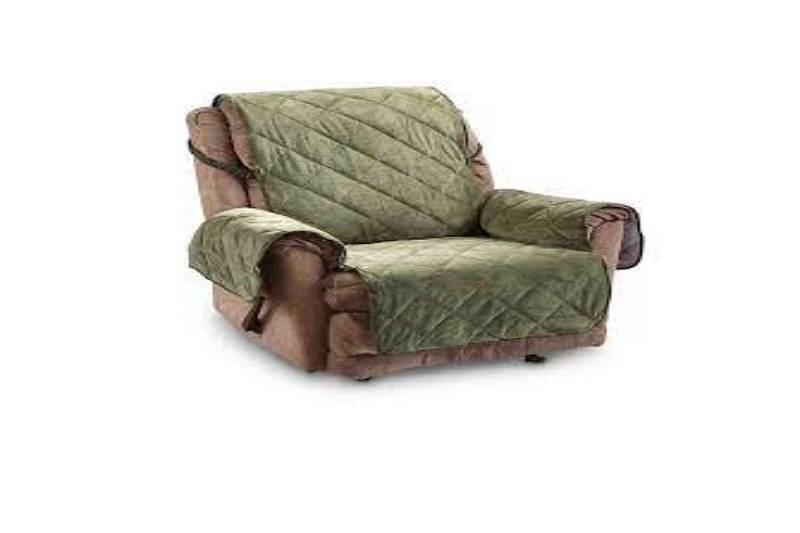Are you looking for a way to spruce up your old recliner? A slipcover is the perfect solution! Making one is not as hard as it may seem, and this blog post will provide 12 steps that detail how to make a slipcover for your recliner.

Steps on Making Slipcover for a Recliner
Step One: Gather your materials. You will need elastic, a sewing machine with thread and needle, scissors, iron-on interfacing or other fusing material such as Peltex (optional), and fabric for the slipcover.
Step Two: Choose your fabric. Ensure that it is heavy enough to provide a good ironing surface, and take into consideration how much of the seat you want covered.
Step Three: Measure the length of the sofa from the back bottom (covering) to front top with measuring tape or ruler.
Step Four: Measure the width of the sofa across, from arm to arm.
Step Five: Add four inches (or two if you have a very thick fabric) for seams and hemming at both ends so that your slipcover will fit over the cushion while staying in place better. Also, measure how high up on each side of the sofa you want the fabric to go up.
Step Six: Cut two pieces of fabric for your slipcover, one that is twice as wide and long as necessary (for a straight hem) and another piece lengthwise on just one side–this will be used for the bottom part of the cover only. Next cut out four strips from an old pillowcase to tie the bottom of your slipcover in place.
Step Seven: Hem both long side edges of each piece with a straight stitch and then sew these two pieces together at one end, leaving the other open for stuffing.
Step Eight: Stuff this cover with batting or old pillows so that it has some weight (but not too much). Tuck the top of your cover under a bit–you may want to use safety pins for this step.
Step Nine: Sew up the last seam on both pieces, making sure you have at least two-inch overlap before sewing so that there’s enough fabric to tuck inside and sew shut later. Then take one of your strips of fabric and sew it to the bottom edge of this opening, catching both pieces of slipcover in one seam.
Step Ten: Tuck the cover inside so that you can finish sewing shut along this final seam–you may need a friend for help with how tight to pull the cover as you’re tucking it back in place.
Step Eleven: Pin the cover to the back of your recliner, and then sew it in place. If you have a bit too much fabric on one side or another, try trimming off some excess inches with pinking shears before pinning everything into place so that you don’t see any raw edges when finished.
Step Twelve: Finally, trim off any excess fabric you can’t tuck under the seat by following your original seam line and clipping away as close to it as possible.
Benefits of Slipcover
Covering: this is a great way to protect the fabric on your recliner, and it’s also good for how dirty or stained upholstery can get.
Reclining Chair Slipcovering Issues: if you have pets who shed hair all over the place–and most do!–you’ll want to vacuum often as well as wash both chair and slipcover on a regular basis to keep it looking as nice and clean as possible.
Dangers of Slipcovers: the only danger with this project is that you might end up spending more time than necessary trying to figure out how best to do it all, or you may find yourself getting frustrated when things don’t go quite right–or when you realize that the slipcover you bought doesn’t quite fit.
How to Care for Slipcover
After you’ve finished the slipcover, it’s important that you take care of both the chair and the cover.
Vacuum often to remove all loose hair from the upholstery–this will help keep your couch clean as well around other furniture.
When the washing machine is full, wash both pieces together on a gentle cycle with cold water.
Don’t use bleach or fabric softener on the slipcover–this can cause it to shrink, tarnish, and lose some of its colors.
How to Prevent Stains on Slipcover
Don’t allow food to sit on the cover for a long time–wash it off as soon as possible.
Use a wet cloth and soap or detergent when cleaning stains, since this will be less abrasive than using a liquid cleaner like bleach.
Always blot (don’t rub) at any spills with paper towels or a clean cloth–don’t scrub.
Don’t use the slipcover for any purpose other than sitting on it, since this will put undue stress and wear on the fabric.
Best Slipcover Fabric Materials
Use water-repellent fabric if you want the cover to be resistant to spills and stains.
Look for fabrics that are made of natural materials like wool, linen, silk, or velvet in the event of spills or a pet incident.
Use stain repellant fabric, since this will prevent most dirt and liquid from sticking to the surface of the covering.
The best fabric to use for the slipcover is a cotton/polyester blend. The mix of these two materials ensures that your cover will not shrink, fade, or get caught on anything if you spill something on it. If spills and stains are an issue in your household, consider using water repellent fabrics–they should be resistant to spills and stains.
BONUS: If you want the cover to be resistant to pet accidents, use a fabric that is made of natural materials like wool, linen, silk, or velvet. These fabrics are typically more expensive than other options but they will last longer–and your pets may not try their luck with them as often!
